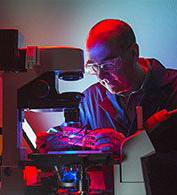An instrument that detect trace levels of materials used in improvised explosives will be used to protect airports and other vulnerable facilities, thanks to researchers at the University of Tasmania. Now they’re working on a smart lab for your smartphone.
The portable device can do complex laboratory-level tests to accurately detect inorganic explosives in less than a minute. The device is being commercialised by Australian company Grey Innovation. In September 2018, the Australian Defence Minister, the Hon Christopher Pyne, launched the commercial prototype.
Homemade bombs, or ‘improvised explosives devices’ (IEDs) are increasingly used by terror groups influenced by ISIS and al-Qaeda. Because they often use common household ingredients they have been difficult to police.
“The instrument can detect homemade bombs of the types used in the Oklahoma bombings, Bali and the Boston marathon bombings and,” said University of Tasmania Professor Michael Breadmore, an analytical chemist at the University.
The technology, called GreyScan, was developed in strategic partnership with Grey Innovation, Australian Federal Police, National Institute of Forensic Science, Australian Customs Service, and US Homeland Security.
The instrument is the product of more than 20 years of research from a team of over 20 researchers, says Professor Breadmore.
The team has also developed laboratory-level tests to diagnose and analyse substances such as blood samples and water pollutants, and the technology will soon be able to link tiny devices to deliver results to smartphones.
“Smartphones can check the weather, get directions and find out most of the information we need - but today’s phone can’t tell us if a glass of water is safe to drink, or test how our body is responding to a drug, or measure the pollution levels in a nearby river,” says Professor Breadmore, who is working to develop a smartphone interface for various portable testing devices.
“Our most sophisticated lab-on-a-chip device targets at-home drug monitoring and incorporates all of the components into a tiny lab-on-a-chip device” he says.
The devices are about the size of a thumbnail and use microfluidics to conduct biochemical operations using an integrated system of tiny channels, pumps, valves and electronics. They can deliver results in around three minutes.
“These mini labs let us perform fast heating and cooling and can be very efficient for some chemical reactions, while being as simple to use as a home pregnancy test kit,” he says.
Smartphone linked detection could revolutionise environmental management, occupational health and safety, policing, and medicine.
Also:
- Chemical analysis is being streamlined through new computer-modelling techniques developed by UTAS researchers. VirtualColumn software models different ways to run a complex lab technique, ion chromatography separation. The simulator was developed in partnership with Thermo-Fisher Scientific (TFS). The software will save hundreds of hours of test-tube guesswork for analytical chemists. The computer models predict the effectiveness of different scenarios for fluids and samples.
- MilliSpot, a blood-sampling technology developed by UTAS researchers over five years to improve the accuracy of common blood tests, has been licensed to local company Housefield Pty Ltd. The technology involves a polymer-based material that allows dried blood from a finger-prick test to be stabilised and stored more effectively than the paper-based material used now.
- hemaPEN has been developed in partnership with Trajan Scientific and Medical through the ARC Training Centre on Portable Analytical Separation Technologies (ASTech) to collect tiny drops of blood by people at home with the accuracy of a fully trained scientist. The pen also preserves the blood sample and protects it from degradation during transport back to a central lab.
Interested in conducting your own research? Apply now to become a research student.
Interested in partnering with the University of Tasmania? Find out more here.



